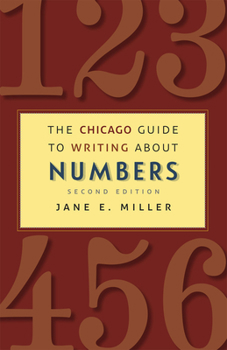The Chicago Guide to Writing about Numbers
Select Format
Select Condition 
Book Overview
Earning praise from scientists, journalists, faculty, and students, The Chicago Guide to Writing about Numbers has helped thousands of writers communicate data clearly and effectively. Its publication offered a much-needed bridge between good quantitative analysis and clear expository writing, using straightforward principles and efficient prose. With this new edition, Jane Miller draws on a decade of additional experience and research, expanding...
Format:Paperback
Language:English
ISBN:022618577X
ISBN13:9780226185774
Release Date:April 2015
Publisher:University of Chicago Press
Length:360 Pages
Weight:1.05 lbs.
Dimensions:1.1" x 5.5" x 8.4"
Customer Reviews
3 ratings
The Chicago Guide to Writing
Published by Thriftbooks.com User , 19 years ago
This is a required text for a graduate course I have enrolled in for fall term. So far, I have found the book makes understanding numbers easier for those (like me) who did not partake in any major mathematical studies prior to a statistics based course.
Competent guide for the quantitative writer.
Published by Thriftbooks.com User , 19 years ago
This is a non-nonsense, practical guide to writing with numbers - something that lots of people do without even realizing it, and often do badly. This book is aimed at a variety of different audiences. It will help anyone writing at the level of a newspaper story. Miller suggests a variety of ways to avoid basic blunders and gaffes. Avoiding errors isn't enough, though, so Miller suggests a variety of ways to bring the meaning and importance of the values to life for a reader - and that's what the exercise was really about. One of her strongest techniques is "GEE", for Generalizations, Examples, and Exceptions. She presents a number of cases that show the general rule expressed by the numbers, specific and representative cases, then the "truth in advertising," the gotchas and caveats that refine any broad-brush generality. Come to think of it, that's not a bad technique for other kinds of descriptive writing, either. Miller extends GEE and her other suggestions to the most rigorous kinds of scientific writing, as well. If anything, bad writing about numbers may be even easier when numbers are so much more critical and have such subtle relationships. It's a bit annoying that Miller refers repeatedly to her other, as yet unwritten book for more advanced statistical topics; I keep getting the feeling that I'm reading only half of something. That leads me to a few other weaknesses I found in this book. The sections on charts, tables, and presentations are competent enough, but could have been a lot stronger. The charting section is especially weak, and should be supplemented by another text about charting specifically. If this is meant as a reference, to be grabbed when a writer hits a snag, it could have been organized a bit more tightly, in more of handbook style. Still there are a few good tables describing common kinds of numbers (fractions, percentages, ratios, absolute differences, etc) and how to handle them, good for a writer's quick fix. The one real weakness comes from one of the book's strengths. Miller really does address number users of many levels of sophistication. She does realize that some people need to make sense of milage comparisons and slanted percentages in the news and in ads, but others deal in z-scores, p-values, and wilder exotica. The problem is that the numerical novice and sophisticate are usually addressed in the same sentence, or at least paragraph. This may be a turn-off for people struggling with the basics, i.e. the people most in need of advice. This is a valued addition to the reference shelf of anyone who presents quantitive information. That's just about every writer, sooner or later. It may help technical illustrators, too, because image and word serve many of the same purposes in presenting information. This should not be your only guide to presenting numbers, but it should be among your tools. //wiredweird
A nice set of ideas and recommendations
Published by Thriftbooks.com User , 19 years ago
This book is a short primer on statistical literacy combined with a style guide on discussing numbers in prose, and through charts and tables. The focus is on numbers that represent data obtained from polls or experiments. The style guide portions are quite basic, are best suited for students, and do not present many different options for presenting data. The parts on statistical literacy, particularly those on presenting data in an intellectually honest manner, are worth reading and rereading for most anyone. Overall, this guide is a decent addition to the reference collection of anyone who writes about data.






